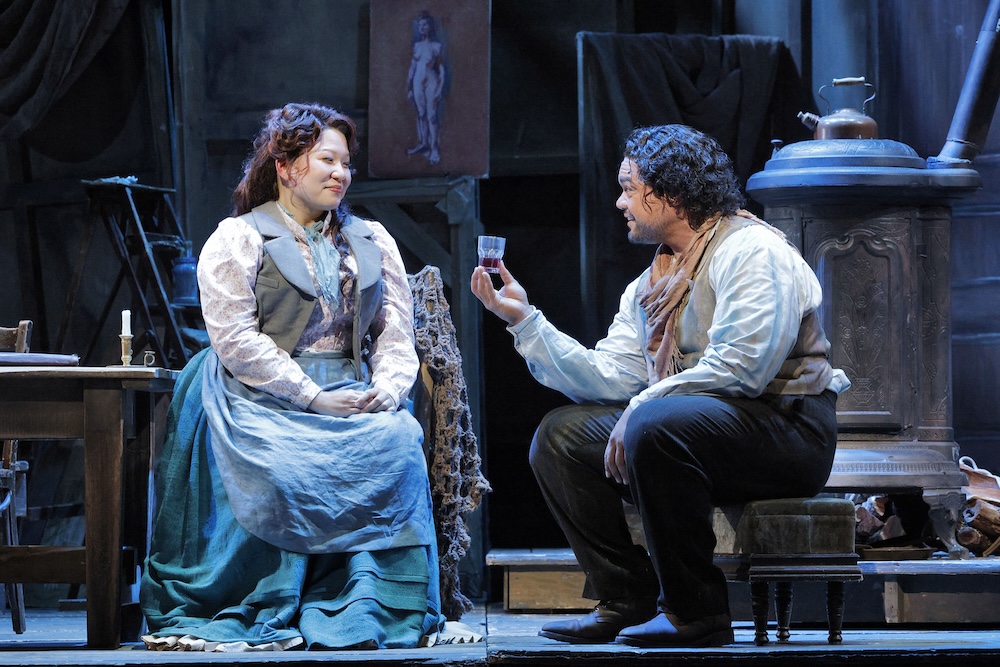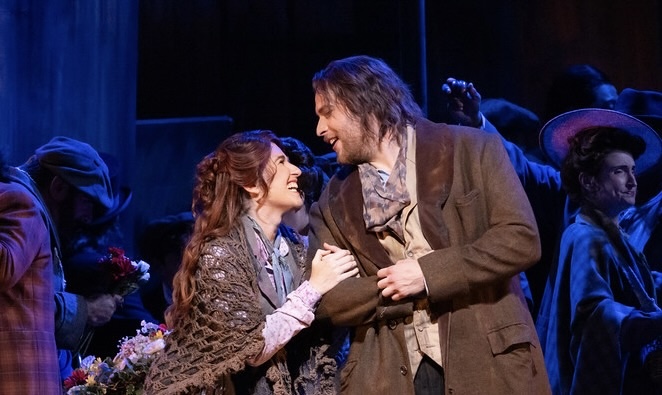La bohème has played in forty-eight of San Francisco Opera’s 102 seasons. In fact, back in 1923 it was the inaugural piece of this grand old American opera company. Here’s news of the latest one.
This 2025 edition is a re-mount of English stage director John Caird’s production first seen in Houston in 2012, arriving in San Francisco for the 2014 season, then revived in 2017. Now in the hands of American stage director Katherine M. Carter, the staging has been refined, focusing on the personalities of its players rather than insisting on Mr. Caird’s very clever idea that bohemian life imitates art — or vice versa.
The big news however of this 2025 edition was the conducting of Florida based, Spanish maestro Ramón Tebar. Beyond eliciting unusual sweetness and delicacy of tone from the San Francisco Opera orchestra, he offered broad musical rhetoric through his manipulation of the flow of Puccini’s phrases, sometimes slowing them, falling delicately behind a singer’s delivery of line, and sometimes anticipating an emotion before it was dramatically realized. There were blasts of unexpected tone here and there, and there were pauses that heightened tension — in the last act a final pause preceded the electrifying blast of the stridently sweet orchestral tone that was Rodolfo’s realization of Mimi’s death.
It was the conductor’s show, richly musical, of exquisitely refined emotions.
The delicacy, intimacy and complexity of Mo. Tebar’s conducting renewed an appreciation of the brilliance of the La bohème libretto, and the perfection of Puccini’s unique verismo in its setting. The conducting also overwhelmed Mr. Caird’s production concept that portrays, in high, slick-theatre terms, this small tragedy in the lives of these garret artists as one with their art — Rodolfo creating a poem of remembrance (or something) as Mimi lay dying.

The period setting of this excellent production was the work of British designer David Farley. The opera played against a backdrop-collage of multiple, randomly hung canvas-like shapes (Marcello is an artist) that suggested appropriate Parisian scenes. The set mechanically (collages flew out and in) and physically (stagehands pushing) transformed, a vista, the artist garret to its facing Cafe Momu, and the bleak place at the Farmers Wall back to the garret. It was a grandly satisfying, if modest, solution for this grand opera showpiece.
Equally satisfying were the casts assembled by San Francisco Opera for this 2025 edition. On June 6 Mimi was sung by Illinois born, former 2006 SFO Merola participant, soprano Karen Chia-ling Ho. A veteran Madama Butterfly (Philadelphia, Boston, Honolulu, et al) Mme. Ho was the 2023 San Francisco Butterfly cover, and the Met’s 2023 Mimi cover. Her Mimi just now was elegantly presented, though without great affect (emotional display). Of beautiful, youthful voice she found very convincing Italianate sounds in her chest voice that added much needed color to her well sung Mimi.
Mme. Ho’s Rodolfo was former SFO Adler Fellow Pene Pati (lead photo, far left). Mr. Pati is a light lyric tenor, a recent San Francisco Opera Nemorino (L’elisir d’amore) though he is making the big house rounds these days (the Met, Munich, Covent Garden) as Rodolfo. He drew the role in smooth, easy musical lines in true, Italianate light lyric tenor colors, the high C in “Che gelida manina” easily accessible. More agile on stage than in less recent times, he brings his great charm to Puccini’s hero, if not the wrenching pathos that a heavier voice might evoke.

Mr. Pati’s garret-mate Marcello (lead photo, far right) was sung by veteran San Francisco Opera baritone Louis Meachem, a recent SF Sharpless as well. Mr. Meachem well fulfills the Puccini roles that require a beautiful voice and a stalwart presence. Rather than attempt the flash and flair of the Mozart heroes, or the emotional depths of an Onegin (roles he has performed at San Francisco Opera), he offered a beautifully sung, solid portrayal of Marcello, skillfully cavorting as needed, dutifully fighting with Musetta as needed.
Mr. Meachem’s Musetta was sung by American soprano Andrea Carroll who lit up the stage with a charming delicacy of both voice and character. There was the sassiness of Zerlina, the innocence of Nanetta, with the musicianship of a Pamina — roles she has performed on the world’s major stages. Mme. Carroll created a subtle, even gentle Musetta, if such a creature can be imagined.
On July 13 (and other performances) Mimi was sung by Australian soprano Nicole Car, a veteran Mimi on many of the world’s major stages. Mme. Car’s early fame was as a Mozart singer, her later fame comes as a full lyric, Verdi soprano, Mimi remains her sole Puccini heroine. She projects a purity of voice, an innocence of persona and a honesty of musicianship that link her to these fragile heroines. It is now a fully mature voice, of significant amplitude, with thrilling overtones that magically enliven her upper voice and her climactic high notes. This San Francisco Mimi well absorbed the complexities of Mo. Tebar’s conducting, and found the subtle, emotional intensity of Mme. Carter’s staging.

Mme. Car’s Rodolfo was sung by American tenor Evan Leroy Johnson. Mr. Johnson sang Lenski in San Francisco Opera’s 2022 Eugene Onegin. He well seconded the operatic nature and physical stature of his garret colleagues, marking this Boheme as grand opera indeed. It is a sizable voice, of a silvery color that he uses with intelligence and taste. Mr. Johnson is a convincing actor, his deathbed scribbling was beautifully timed to the libretto’s final Rodolfo/Mimi duet. And, of course, his final cries were heartbreaking.
Lucas Meachem (see above) sang Marcello, an 11th hour replacement for baritone Will Liverman, the announced Marcello for three of the eight performances. Mr. Meachem’s Musetta was here sung by American soprano Brittany Renee. A Bess in Porgy and Bess at the Met (and elsewhere) as well as a Met and Houston Musetta, she brings great vivacity to this San Francisco Musetta, “Quando me’n vo” the usual showstopper.
Of special note was the Schaunard (all performances), sung by SFO’s Adler Fellow baritone Samuel Kidd (lead photo, third from left). Main stage recruits from SFO’s young artist program are often over-parted. Not so with Mr. Kidd who defined a large, vivid character for this often overlooked Rodolfo cohort. Further gold-plated casting was the Colline (all performances) sung by Romanian bass Bogdan Talos (lead photo, second from left). As all the characters in this staging by stage director Katherine Carter, his Colline was subtly stated, he offered his small coat aria seated alone, far stage right, making his solitary sacrifice a hugely poignant moment.
San Francisco Opera veteran character bass-baritone Dale Travis brought his usual broad caricature to the roles of the garret landlord Benoit and Musetta’s rich old suitor Alcindoro, adding fine dress to the many performative moments inherent to La bohème. San Francisco Opera Chorus member Chester Pidduck sang Parpignol.
Michael Milenski
War Memorial Opera House, July 6 and July 13, 2025, San Francisco, California, USA
All photos of the July 6 performance copyright Cory Weaver, the July 13 performance photo copyright Matthew Washburn